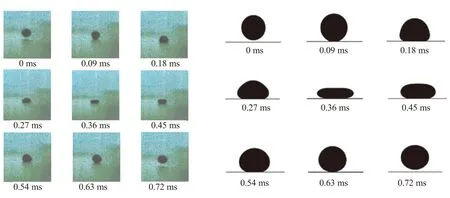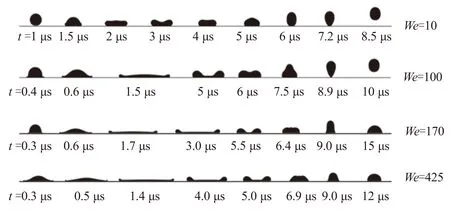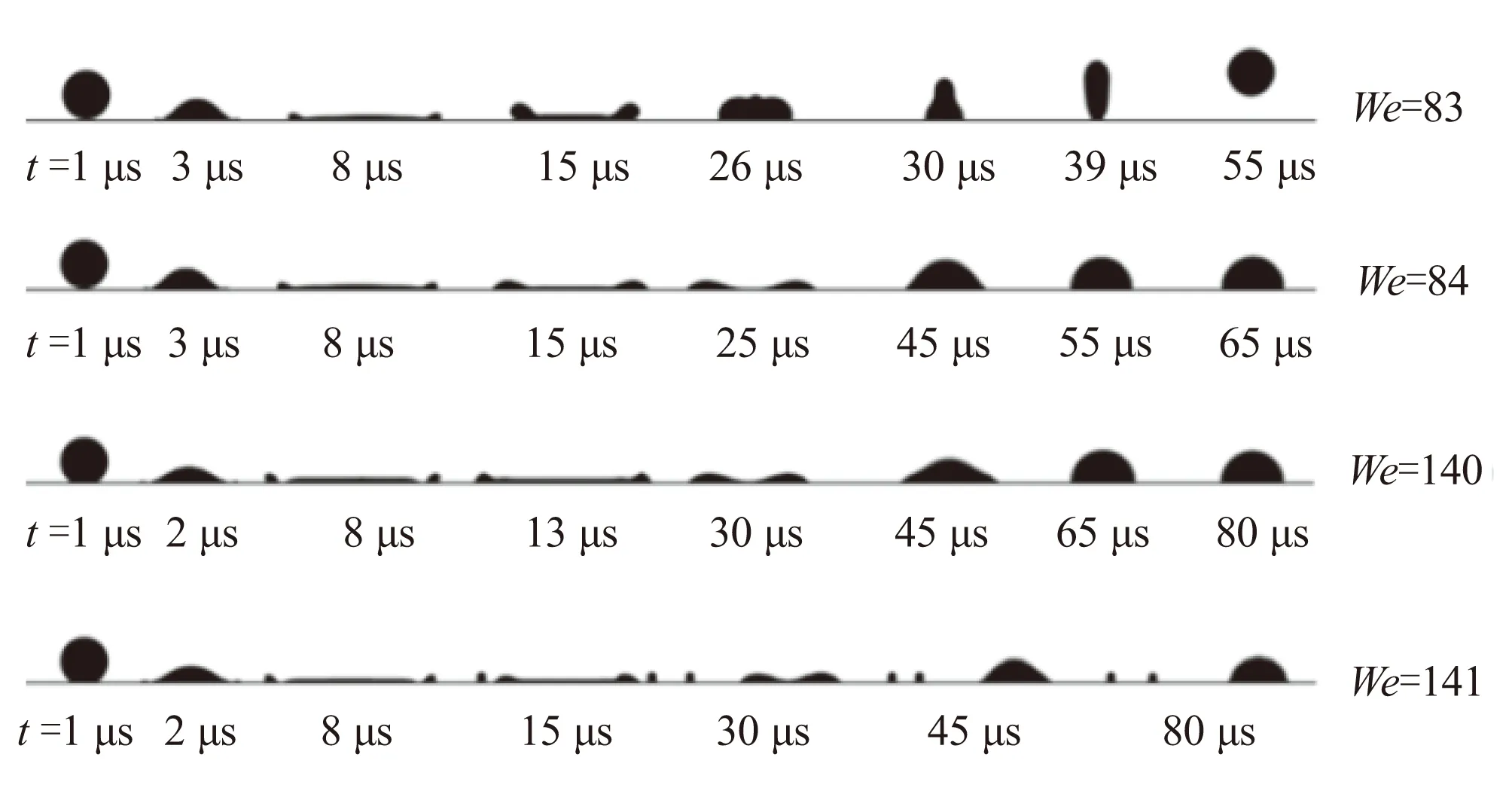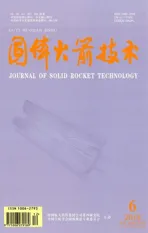Investigation on the deformation of aluminum and alumina droplet during its impact on the wall①
2019-01-18WUGuanjieRENQuanbinFUYuLIUYuanminHUChunbo
WU Guanjie, REN Quanbin,, FU Yu, LIU Yuanmin, HU Chunbo
(1. Science and Technology on Combustion, Internal Flow and Thermal-structure Laboratory, Northwestern Polytechnical University, Xi'an 710072, China; 2. The Fourth Academy of CASC, Xi'an 710025, China)
Abstract:The micrometer-size alumina droplets usually impact on the wall of solid rocket motor during combustion process. Considering the high melting point of alumina, the droplet-wall impingement experiments were carried out by the molten aluminum as a demonstration. The volume of fluid (VOF) and adaptive grid methods have been used to numerically simulate the aluminum droplet-wall impingement experiments, which have been used to validate the numerical models. The deformation process of micrometer-size alumina droplets that impacted on the wall have been calculated by the validated model under different droplet velocities and sizes. The results show that the numerical simulation process is basically in accordance with the experiment. With the increase of the initial impacting velocity, alumina droplet would rebound, stick, and breakup successively after impacting on the wall. With the increase of the diameter, the critical Weber number of alumina droplet between rebound and stick, stick and breakup decreases accordingly. The rebound-stick critical We number of 20 μm, 50 μm and 100 μm alumina droplet vertically impacting on the wall are 170, 84 and 50 respectively, and the stick-breakup critical We number of impacting alumina droplet in diameters of 50 μm and 100 μm are 141 and 129. The droplet breakup must have sufficient kinetic energy to overcome the energy consumed by viscous flow and surface tension.
Key words:alumina droplet;directly numerical simulations;self-adaptive grid method;critical We number
0 Introduction
Alumina droplet impacting on the wall is a common phenomenon in the combustion chamber and nozzle convergence section of solid rocket motor[1]. Aluminum/alumina droplets will impact on the surface of insulation layer and lead to particle deposition and erosion, which is a unique phenomenon of combustion gas flow in aluminized rocket motor[2-3]. The process of droplets impacting on the wall has been a very important physical process to research.
The previous researches of droplet impacting on the wall mainly focused on the water droplet impacting on the wall. Leidenfrost[4]performed the experiments of water droplets impacting on the hot iron spoon, and the water droplets kept suspending for few seconds over the iron spoon. Wathers[5]found whether the droplet rebound or stick after impacting the hot wall mainly depended on Weber number, and the criticalWevalue of bounce and stick was 40. Zhang[6]summarized that the glycerol droplet impacting on the wall was a viscous impact whenRewas less than 20, but an inertial impact when theRewas over 230.
However, previous studies on droplets impacting on the wall were mainly on the low-melting-point droplets[7-9]. The alumina droplet has higher surface tension than the droplet at normal temperature. Therefore, in the study of droplet-wall impacting regulation, the low-melting-point droplet cannot be used to replace the alumina droplet, but the properties of molten aluminum droplet are much similar to that of the alumina droplet. In this paper, the experimental device for aluminum droplet impacting on the wall was set up, and the open-source program Gerris was used to directly simulate the experiments of aluminum droplet impacting on the wall. Meanwhile, a lot of numerical simulations about the alumina droplet impacting on the wall were carried out by Gerris. Furthermore, the influence of velocity and diameter on the droplet impacting on wall was researched.
1 Approach
1.1 Experimental apparatus
In consideration of the high melting point of alumina, it is very difficult to conduct the experimental research on alumina directly. However, the aluminum has high surface tension, which is similar to alumina, and their physical parameters are very approximate. Therefore, the experiment of aluminum droplet impacting on the graphite wall was carried out in this paper, and the accuracy of numerical calculation was verified by the experimental results. The experimental system of molten aluminum droplet impacting on the wall is mainly made up of the heating system, cooling system, gas supply system, control system, acquisition system and the obturation device. The heating system is a high-frequency induction heater, which is mainly used for melting the metal aluminum; the gas supply system mainly adopts argon, which can be used as the driving gas for the generation of aluminum droplets and the environmental protection gas; the cooling system provides the temperature protection for some components by water cooling; the control system with the high-response control hardware and professional software, is mainly used to control the high-frequency solenoid valve, whose working time is in milliseconds, so that the single metal droplet can be generated; the acquisition system mainly includes pressure and temperature acquisition, and the high-speed photography; the obturation device contains a closed container used for argon environment, and a graphite crucible for molten aluminum. A transparent quartz window is inset into the closed container for observing the deformation process of aluminum droplet-wall impingement. The whole experimental system is shown as follows in Fig.1.
The working principle of the experimental device is that a high-frequency induction heater is used for heating the graphite crucible, and the solid aluminum in the crucible is melted; then the molten aluminum is ejected from the nozzle at the end of the graphite crucible by controlling the mass flow rate of argon gas in the graphite crucible, and the molten aluminum droplet was generated by the precise working time of high-frequency solenoid valve. Subsequently, the aluminum droplet with a certain speed impacts on the smooth graphite wall, and the impacting process is shot by the high-speed photography. The deformation process of aluminum droplet impacting on the wall is obtained.
1.2 Numerical method
The phenomenon of droplet impacting on the wall is the typical two-phase flow. In this paper, Gerris[10], a computational fluid dynamics program based on the VOF interface tracking method, is used to perform the direct numerical calculations on the droplet impacting on the wall. In the method of VOF, the volume rate functionC(x,t) is used to describe the volume fraction of the fluid in a grid cell: the grid cell is completely occupied by a certain liquid whenC=1, and it doesn't have liquid whenC=0, while the liquid and gas occur simultaneously in one grid when 0 ∂tC+·(Cu)=0 (1) The control equations used in this paper include non-stationary incompressible continuity equations and the Navier-Stokes equations. The time-interleaving method is used to perform the discrete on the equations of volume fraction, density and pressure, and the surface tension and gravity are added as source terms to the N-S equations. The equations are as follows: ρ(∂tu+u·u)= -p+·(2μD)+ σκδsn+ρg (2) ∂tρ+·(ρu)=0 (3) ∂tC+·(Cu)=0 (4) whereu(u,v,w) is the fluid velocity,ρis the fluid density,μis the dynamic viscosity,σis the surface tension,κis the droplet curvature,nis the normal vector of wall, andDis the deformation tensor;δsshows that the surface tension term only exists at the two-phase interface, andρgis the gravity term. The density and viscosity can be expressed by the VOF functions as follows: ρ(C)=ρ1(C)+ρ2(1-C) (5) μ(C)=μ1(C)+μ2(1-C) (6) whereρ1is the density of the liquid,ρ2is the density of the gas,μ1is the dynamic viscosity of the liquid, andμ2is the dynamic viscosity of the gas. In the aluminum droplet-wall impingement experiment, the temperature of molten aluminum is controlled at 977 K, and the graphite wall will be heated to 933 K, while the argon environment temperature of the aluminum droplet impingement part is around 473 K. The whole impacting process is performed in an argon atmosphere to ensure that the aluminum droplet surface does not oxidize, and the whole deformation process of the droplet impacting on the wall surface is photographed by high-speed photography. Table 1 shows the experimental parameters of aluminum droplet impacting on the graphite wall vertically, and the contact angle between the aluminum droplet and the graphite wall is 161°. Table 1 Experimental parameters of aluminum dropletimpacting on the graphite wall The VOF method was used to directly simulate the experimental process of aluminum droplet impacting on the wall, so as to verify the reliability of the numerical model. According to the experimental parameters in Table 1, Gerris was used to perform the numerical calculations of aluminum impacting on the wall. Considering that the particle sizes of alumina droplets in the combustion chamber of solid rocket motors are mainly below 100 μm and the gas flow velocity is generally not higher than 60 m/s, the Weber number of alumina droplets is 10~450, and theRenumber is 38.85 ~ 253.25. In this paper, the influence of particle size and velocity of alumina droplet on the behavior pattern of droplet-wall impingement process is studied. Therefore, the diameter of the alumina droplet is set as 20~100 μm, and the impacting velocity is 6.7~69.78 m/s. The physical property parameters of alumina droplets and gas phase are as shown in Table 2. In the solid rocket motor, as surface of the heat-insulating material is greatly influenced by the operating mode, it is very complicated to judge the wettability between the droplet and the insulating surface, thus the solid wall contact angleθis set as 90°, namely the dividing angle of the wetting property. Table 2 Parameters of alumina droplet and gas phase The experiment and simulation result of 730 μm aluminum droplet impacting on the graphite wall at a velocity of 1.01 m/s are shown in Fig.2. It can be seen that both the results of numerical simulation and experiment on the aluminum droplet-wall impacting process are very similar. The aluminum droplet is symmetrically spread over the impacting point under the inertia force, and it reaches the maximum spreading length at 0.36 ms. Then, the aluminum droplet begins to shrink to the center part. The height of aluminum droplet bulge increases continuously during the retracting process, and the aluminum droplet gains an upward speed. Finally, the droplet is completely rebounded by resistance to the gravity under the effect of kinetic energy and surface tension. The evolution of the pressure and velocity is shown in Fig.3. Whent=0.1 ms, the colliding is in the spreading stage, the internal pressure of aluminum droplet is concentrated on the surface between the droplet and the wall, and it gradually decreases along the normal direction. Then the droplet is gradually spreading under the inertia force, and the pressure on both sides of the droplet increases gradually. Whent=0.38 ms, the kinetic energy of the droplet is completely converted to the surface energy, and the droplet begins to shrink under the surface tension. Whent=0.60 ms, the pressure at the bottom of the droplet is less than that oft=0.1 ms, which is mainly because the droplet is subjected to the upward inertial force. Subsequently, the kinetic energy counteracts the viscous dissipation energy, and the droplet bounces off the wall. (a)Experimental result (b)Simulation result (a)Spreading stage (b)Retraction stage In order to describe the changing process of different energies in the impact process of aluminum droplet, each energy is tracked and calculated, including the kinetic energy (KE), the surface energy (SE), the viscous dissipation energy (VDE) and the total energy (TE). The total kinetic energy of the droplet is calculated by the integration of the kinetic energy and the volume rate function. The droplet surface energy can be calculated by the product of the surface tension coefficient and the surface area of the droplet. The viscous dissipation energy is calculated by the time integral of the viscous dissipation rate (VDR), which belongs to the cumulative viscous dissipation energy. The total energy is the summation of kinetic energy, surface energy and viscous dissipation energy. The formulation ofVDRunder two-dimensional axisymmetric condition is shown as follows[13]: (7) In Fig.4, theKE,SE,VDEandTEat an instant are nondimensionalized by initialTE. It can be seen that the balance of the original droplet surface tension is broken when the aluminum droplet contacts the wall surface, and the liquid interface is deformed and the bottom is compressed. TheKEkeeps decreasing, andSEandVDEkeep increasing during 0 ms to 0.4 ms, which is the aluminum droplet spreading stage, and the kinetic energy of the droplet is transformed into surface energy and viscous dissipation energy. Fig.4 Relationship between differentenergy and contact time At this time, the deformation of droplet is sharp, which lead to the high viscous dissipation rate; from 0.4 ms to 0.7 ms, theSEdecreases continuously, andKEandVDEincrease slowly, and the surface energy of the droplet transforms into kinetic energy and viscous dissipation energy. At this time, the viscous dissipation rate of droplets is lower than that of the spreading stage. In addition, it can be seen that the kinetic energy of the droplet is higher than the viscous dissipation energy during the deformation process, and the droplet leaves the wall under the action of the residual kinetic energy. As the initial velocity of alumina droplet impacting on the wall changes, the appearance of droplets impacting on the wall changes correspondingly. In Fig.5, it shows the deformation and rebound process of 20 μm alumina droplets impacting on the wall at the impacting parameter Weber number is 10, 100 and 170 respectively, and the initial velocity is 10.70, 33.85, 44.13 and 69.78 m/s. Fig.5 20 μm alumina droplet impacting on the wallwith different Weber number The calculation results of 20 μm alumina droplet vertically impacting on the wall in the Fig.5 shows that, the droplet rebounds in the low velocity, and it will stick on the wall when the velocity is high. When the Weber number is 10 and 100, the alumina droplets spread and retract after impacting on the wall, and it rebound off the wall at the end. When the Weber number is 170 and 425, the movement process can be divided into four periods: rapid spreading, retraction, oscillation and stabilization. After stabilization, the droplets stably adhere on the wall. However, no breakup or spattering occurred in the calculation range of 20 μm alumina droplet vertically impacting on the wall in this paper. Fig.6 shows theWe-Redistribution diagram of rebound and stick of 20 μm alumina droplet vertically impacting on the horizontal wall. The critical Weber number of rebound and stick is 170. This is mainly due to the high viscosity and surface tension, and it is different from the water droplet, which has low viscosity and surface tension. During the working process of the rocket motor, the size of the alumina droplets ranges from submicron to several hundred microns. Because of the unevenness of the size distribution, the influence of droplet size on the impingement results needs to be investigated[14]. The numerical calculation results of 50 μm alumina droplet impact on the wall is shown in Fig.7. When the Weber number is 83, 84, 140 and 141 respectively, the initial velocity is 19.50, 19.62, 25.33 and 25.42 m/s. It can be seen that 50 μm alumina droplet-wall impingement results have three types: rebound, stick and breakup. When the Weber number is lower than 83, the alumina droplet will rebound after impacting on the wall; when it ranges from 84 to 140, the droplet will stick; when it is more than 500, the droplet will breakup. This is different from the types of impingement results of 20 μm alumina droplet, which is due to the larger diameter. Fig.6 20 μm alumina droplet impacting on the wallwith different Weber number Fig.7 50 μm alumina droplet impactingon the wall with different We The results of 100 μm alumina droplet impacting on the wall are similar to that of 50 μm droplet, but the critical Weber numbers between rebound and stick is 50, and that of stick and breakup is 129. The morphological changes of alumina droplet with the same impingement results at different impacting velocities are approximately similar. The regional distribution diagram of 20~100 μm alumina-wall impingement result is shown in Fig.8. It can be seen that with the diameter of the alumina droplet increases, the conversion critical Weber number between rebound and stick, stick and breakup decrease correspondingly. This is because the Weber number actually is the ratio of inertial force and surface tension, and with the increase of diameter, the increasing rate of inertial force is higher than that of surface tension, it is easier to breakup for bigger droplet in lower Weber number. Fig.8 We-D distribution diagram of the results inthe alumina droplet impacting on the wall The energy evolution in alumina droplet impacting on the wall during the 50 μm alumina droplet deformation is shown in Fig.9, and the value ofSEandKEat an instant are the ratio of initialSEandKE, respectively. The temporal evolution ofKEandSEfor different impingement results is shown in Fig.9. Fig.9 Energy evolution of 50 μm aluminadroplet impact on the wall The maximum surface energy of droplets increases with the increase of dropletWenumber, and the final surface energy of the droplet is basically consistent with the initial surface energy in the rebound and stick results. While, the final surface energy of the droplet increases 12% in the breakup result. This is because that the small droplets separated increase the surface area of the droplets. However, the droplet still has a certain kinetic energy in the rebound result, and the kinetic energy of droplets gradually approaches zero in stick and breakup results. In conclusion, the viscous movements of droplets dissipate most of the energy in the impacting process. Therefore, the breakup of droplet must have sufficient kinetic energy to overcome the energy consumed by viscous flow and surface tension. In view of the phenomenon of alumina droplet impacting on the wall, the direct numerical simulation of micrometer alumina droplet-wall impingement process is carried out by the VOF interface tracing method and the adaptive mesh discrete program. With the increase of the initial velocity, the alumina droplet has the phenomena of rebound, stick and breakup after the vertically impacting on the wall. The morphology changes of the droplets impacting on the wall with different diameters are basically similar. It is easier for alumina droplets with large diameter to have the phenomenon of breakup than the small droplets. The droplet breakup must have sufficient kinetic energy to overcome the energy consumed by viscous flow and surface tension. With the droplet diameter increases, the critical Weber number of rebound-stick and stick-breakup decreases accordingly.1.3 Research proposal


2 Results and discussion
2.1 Aluminum deformation process analysis



2.2 The effect of the initial velocity

2.3 The effect of the initial diameter



2.4 The evolution of the energy

3 Conclusions
